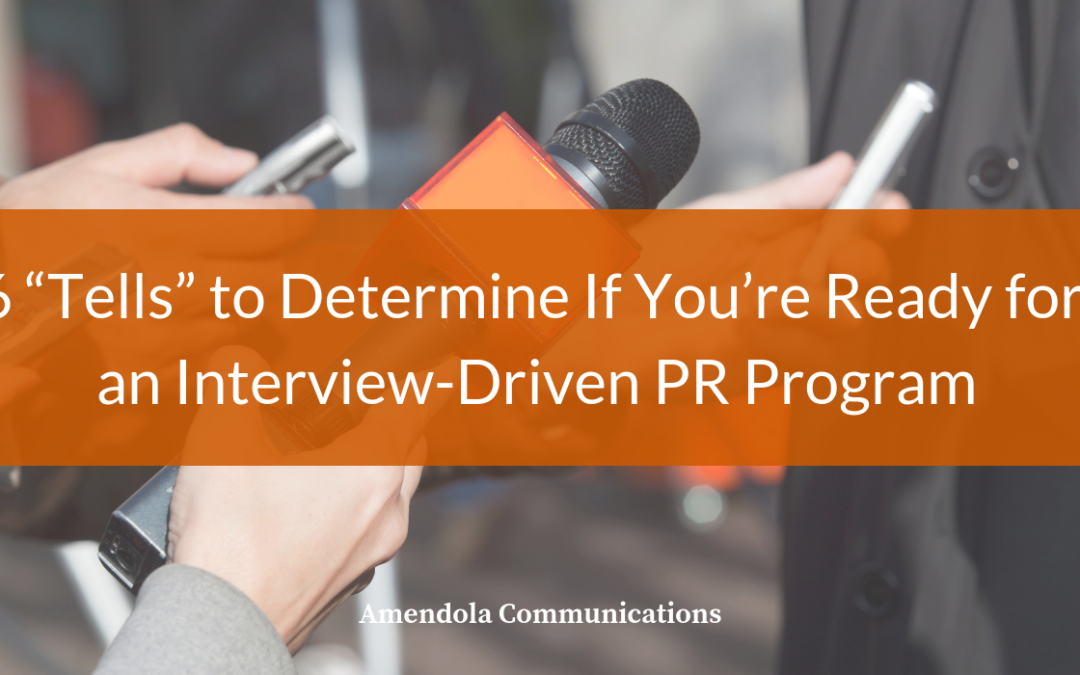
by Ken Krause | Jul 10, 2019 | Blog
It all sounds good in theory. The CEO, VP of sales, chief marketing officer, or some other higher-up decides that the key to boosting sales, raising funding, or driving some other positive business event is to launch an interview-driven PR program.
“We need our executives to be viewed as experts by our target audience,” they declare. “Having them interviewed by trade publications, or even the national media, will help us build visibility and credibility, which will bring prospects flocking to our website.”
There is definitely some truth in that. Having your executives regularly commenting on industry news and trends, especially in the trade media, can have quite the halo effect on the company as a whole.
Here’s the thing, though. There’s more to it than hiring a PR agency and expecting them to set up interviews. Even the best PR agency in the world (notice where that description links to) can’t do it by themselves no matter how much you pay them.
Creating a successful interview-driven PR program requires a lot of coordination and collaboration between the client (your company) and the agency. It also requires a few elements that your company is solely responsible for.
If you can’t deliver on them, the interview-driven PR program is destined to fail.
So how do you know whether you’re prepared to embark on that particular journey? Just like in playing poker, there are a few “tells” involuntary actions or gestures that indicate how strong your hand is. Here’s a look at a few of them.
Your executives like doing media interviews
It seems rather obvious, but it actually isn’t. Some people don’t really like being interviewed, or talking about themselves. This is often true of technology experts who launch companies, or clinicians in healthcare and health IT.
Ideally the person selected to do media interviews enjoys the process to some extent. His/her enthusiasm for the company and the topic will be contagious, leading to great coverage.
If you don’t have such a spokesperson, and can’t hire one in, the other solution is to media train the executives you do have. Often the lack of comfort comes from being unfamiliar with or unaccustomed to speaking with strangers in that type of setting. Media training can help alleviate those concerns and turn a wallflower into a media star. Or at least a likable, credible spokesperson.
Your executives will make time for media interviews
This is often a tougher attribute to find, especially in a smaller organization where C-suite execs are not just running the business but meeting with customers, talking to investors, rallying the troops and perhaps even getting involved with product design and execution.
Yet it’s essential. Most reporters (and editors) operate on tight deadlines, and have multiple stories brewing at once. If your executive can make him/herself available when the reporter has time to talk, the reporter will likely move on to someone who can.
Most of the time the window will be a day or two. Sometimes, however, the window will be within an hour or two. And the larger and more desirable the media outlet, the more likely it will be the latter.
If your executives want a week’s notice (or more) to schedule an interview, you’re probably not going to get much coverage. Unless the executive is already incredibly rich and famous, it’s important to understand that securing the interview means being ready to speak whenever the reporter is ready. Of course, if the executive is already rich and famous, he or she can usually dictate the terms of the interview. For everyone else, it’s ask and react.
Your executives have interesting, non-self-promotional stories to tell
Unless the media outlet wants to do a profile of one of your executives or the company, most interviews are not going to be inwardly focused. Instead, the executives will most likely be asked to comment about the news of the day or longer-term industry trends.
For example, in healthcare if an executive is asked to comment about interoperability, the reporter isn’t especially interested in hearing about how interoperable the company’s product is. At least not at first.
Instead, the reporter is looking for insights about interoperability in general that readers or viewers can’t read or see anywhere else. It doesn’t have to all be original; it could be taking two disparate factors and showing a previously hidden relationship between them.
Whatever is said, though, it has to offer evidence of more universal, big-picture thinking that helps the reporter move the story forward. Even better if the reporter says, “I never realized that.”
This, incidentally, is why reporters are often reluctant to interview the VP of sales. They’re afraid they’re going to have a 30-minute conversation about the features of the company’s products.
Offer up great information and insights, however, and the executive won’t just get quoted. He or she will become a go-to resource for that reporter.
Your executives can customize the story to the audience
Most high-ticket products and services require several levels of approval before they can be purchased. There are also usually certain job titles that, while they can’t say yes, can definitely say no.
The executive being interviewed must be able to speak to each of them regarding things they care about in terms they can understand. A CIO at a hospital will likely have different concerns about an issue than the chief medical officer, or the chief nursing officer, or an emergency department physician, or someone in the business office.
In an interview the company executive must not only understand who the media outlet’s audience is but how to frame the discussion in terms they care about. The same generic talking points won’t work for all.
This is a skill all unto itself. It can be learned, but it most definitely must be practiced. The more the executive can customize the story, the better chance it has of finding its mark.
Your executives know they may not make the cut
Even if your executives do a great job in their interviews, there may be times they don’t appear in the story anyway. The focus of the story may have changed, or the editor didn’t like something about what was said, or the story may have been running too long, or a dozen other things may have happened.
They need to understand it happens from time to time and just move on to the next interview. Now, if it happens several times in a row it may be time to review the message and how it’s being delivered.
Most of the time, however, it’s just a glitch or an unfortunate circumstance. Even great poker players get hands they can’t bluff their way out of. Simply fold that hand and focus on the next one.
Your executives understand they can’t control the final output
At the end of an interview, company executives will often ask if they will be able to review a story before it comes out. With rare exceptions, the answer is no.
It’s nothing personal, it’s just not done. Which means the executives, and the organization as a whole, will have to understand there is some risk that the reporter will get something wrong, or write something they don’t like.
That said, most reporters, especially those in trade publications, are not looking to do a hatchet job on the executive or the company. But they’re not there to be cheerleaders either.
They want to present a fair and balanced story that conveys verifiable information to their audience.
If they get a fact wrong, spell the company’s or executive’s name wrong, or make some other object error most reporters (or their editors) will correct it. But if the company’s corporate messaging says X and the article doesn’t read that way, it’s likely to stay that way.
Knowing that, and being able to live with it, will drive a lot more interview coverage than insisting on controlling every aspect of the final piece.
Going all-in
Clearly, focusing on an interview-driven PR program isn’t for everyone. In some cases, a content-driven program might be a better approach.
But if you have one or more executives who are knowledgeable about the industry, love to talk about it (even on short notice) and understand there may be an occasional miss among the many hits, it’s time to start interviewing PR agencies so your media star can be born.
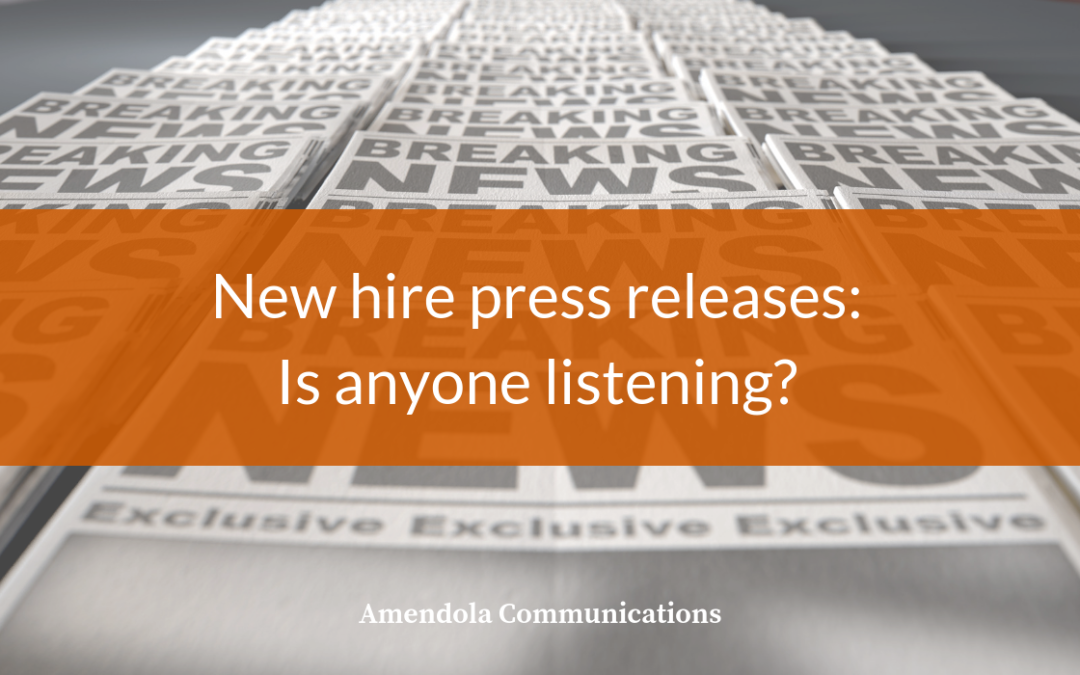
by Brandon Glenn | Jul 3, 2019 | Blog
Anyone who’s been in the media, marketing or communications industries has likely seen hundreds. If you’re an ex-reporter-turned-PR-guy like me, then you’ve no doubt seen thousands.
Unfortunately, I’m not talking about performance bonuses or letters of adoration from admirers. I’m talking about new-hire press releases.
Just about everybody issues them, but not exactly every media outlet covers them. In fact, quite a few health IT publications don’t regularly cover new hire announcements that aren’t of the big-name, big-company, big-title variety. (In other words, if your release is about the new CEO at Cleveland Clinic or chief technology officer at Haven, the new Amazon-Berkshire-JPMorgan healthcare company, you don’t have to worry about much of this.)
For large companies and for CEO hires, it’s standard practice to issue a press release. For everyone else, the situation gets a little murkier. So, in those cases, are new hire releases worth the investment of time, effort and resources? Often, yes, though certainly not always.
For anyone on the fence about issuing a new-hire press release, here are three questions that may provide clarity on which way to go:
Can you benefit from local media coverage? Some companies are interested only in national and trade coverage, electing to eschew local coverage, and that’s fine. For example, it might make little sense for a company interested in reaching decision-makers at electronic health records (EHR) companies to obtain media coverage in its local market, because there may be few, if any, EHR vendors headquartered there. In other cases, it could be advantageous, such as when a young company has received a venture capital investment and wants to go on a hiring spree and could benefit from some local publicity. New-hire announcements are much more likely to generate local coverage than national or trade coverage, so companies seeking local coverage may benefit from a release.
Are you looking to generate market awareness? Just because national and trade journalists elect not to write about a new hire, it doesn’t mean that no one is paying attention. Analysts, investors, reporters and close other-industry observers in those words, people whose job description includes following the latest development health IT may very well notice. Press releases, in general, and new-hire releases, in particular, are an excellent way to introduce your company’s name to people who may later become valuable contacts.
Did you recently launch a new initiative? Maybe you’ve recently launched a new product, entered a new market or shifted your company’s strategy. A new hire release is another means of spreading the word, even if you’ve mentioned it earlier in a prior release — assuming this initiative is any way connected to the hire. When I was researching a new company in my reporter days, one of the first steps I’d take was to scan the company’s press releases page on its site because it gave me a strong idea of what the company considered its major to-date accomplishments. In that respect, think of a company’s press releases new hires, included as a track record of the noteworthy achievements it wants to share with the world.
Though sometimes regarded as the red-headed stepchild of press releases, new-hire press releases can be worthwhile and valuable; just make sure you ask yourself the above questions before publishing one.
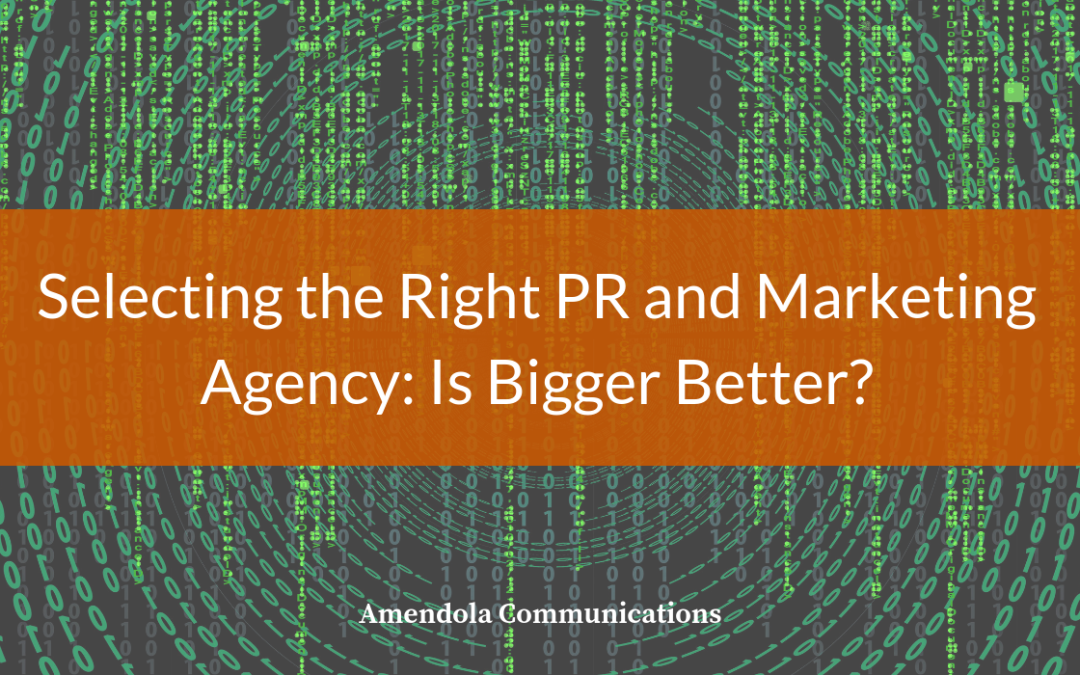
by Jodi Amendola | Jun 26, 2019 | Blog
When it comes to finding the right PR and marketing agency, is bigger better?
It depends who you ask.
Early in my career as an agency leader, I was surprised that it was Amendola’s largest Fortune 500 clients who most clearly understood and could articulate the benefits of working with a smaller, boutique agency. As time passed and a few comparatively smaller clients switched to a bigger agency (often in response to reaching a major growth milestone) and subsequently came back, I realized that the larger, more well-established companies simply had the benefit of experience. They’d previously worked with one or more large corporate agencies, and already understood the advantages and drawbacks.
So why do many of the world’s largest, most successful healthcare and technology companies prefer to work with smaller, highly specialized agencies? It’s a fair question, and the answer can help healthcare/healthcare IT companies of every size find their ideal agency fit.
Depth of understanding is even more key in a complex industry
Many of Amendola’s largest clients voice frustration with the inconsistent levels expertise at big agencies, especially those that don’t focus exclusively on healthcare and healthcare IT.
As one Fortune 500 client said in our initial conversation, “We don’t feel like we’re getting any value from [large corporate agency]. They understand tech in general, but don’t really have a clue about healthcare IT. And they don’t seem to have any of the media relationships we need.”
Another prospective client put it more wryly: “We spend half our time explaining value-based care, and the other half reminding them to stop talking about it like it’s brand new.”
To be fair to larger agencies and the hardworking folks who make them hum, it’s all but impossible for anyone to be an expert on multiple complex industries. Especially if one of them is healthcare. In fact, that’s why Amendola serves only healthcare and healthcare IT clients, and has since the outset. There’s always something new to learn in healthcare, and always something on or just over the horizon that will impact the industry in unexpected ways. If you don’t eat, sleep, and breathe it, how could you possibly keep up?
Still, I can understand these clients’ frustration. If an agency needs constant coaching on what’s happening in healthcare, the best case is that the relationship becomes more time-consuming for the client.
The more realistic case? Missed opportunities, muddled messaging, and even missteps in the market.
It’s harder for large and multi-industry agencies to develop strong healthcare/healthcare IT media relationships
Clients also often mention that a larger agency they worked with was unable to secure high-quality (or even very many) media opportunities. I’m never surprised to hear it. After all, any junior PR professional can pitch journalists all day every day every…but how effective can they be if they don’t really understand the story they’re pitching?
Yet inconsistent expertise isn’t the only contributing factor. The fact is, large agencies have several things working against them when it comes to healthcare/healthcare IT media relations.
Imagine you’re a healthcare reporter. You’ve just been assigned a 1,200-word article about how healthcare organizations are screening for unmet social needs and addressing SDoH, especially within their high-risk/high-cost patient populations. Your editor would like to see you include perspectives from at least three different organizations. Either vendors or providers, but at least one of each. Oh, and it’s due tomorrow. End of day today would be better.
Now ask yourself who you’d reach out to:
- The comparatively junior contact you have at a big corporate agency you know, the one who keeps pitching you out of the blue about the same one or two clients.
- The comparatively senior contact you have at a smaller, healthcare-specific PR agency you know, the one with a diverse client portfolio who can probably be your one-stop shop for all three of the interviews you need to conduct.
Actually, any chance you could turn the article around sooner? It’d be great to get it out on social ASAP.
The hotter the topic and the busier the news cycle, the higher the demands on journalists’ time and attention. During the weeks preceding HIMSS, it’s not uncommon for a healthcare reporter at a top-tier publication to receive well over 200 pitches a day. From a purely practical standpoint, the only way they can wade through the noise is to focus on their most reliable agency contacts (who, by the way, have been regularly pitching and checking in on HIMSS opportunities for months, not weeks).
How much of a difference do strong media relationships make? Consider the Fortune 500 client I mentioned earlier.
In our first month working together, we secured more media opportunities for them than their most recent large corporate agency had secured over the course of three years.
Now, did our agency-wide expertise in healthcare and healthcare IT enable us to craft higher quality, more sophisticated pitches and thought-leadership content? Absolutely. Did we also do a better job targeting the right reporter/editor/publication with the right pitch at the right time? You bet your bylines.
But the wealth of opportunities we had to choose from were partly a function of a fundamental truth about healthcare/healthcare IT PR. As a boutique agency exclusively serving healthcare and healthcare IT clients, we hear about opportunities that larger and less focused agencies don’t because healthcare journalists’ lives are already hard enough.
Another key difference: Who’s *really* doing the writing?
The complaint I hear most frequently from prospective clients is the amount of time they spend rewriting the content their current agency produces. The shared sentiment is, “in the time we spend rewriting everything, we could have just drafted it ourselves.” And that isn’t just an idle thought for many companies when I spoke with a large publicly traded company last week, they explained they use their current agency for media pitching only, having brought all content creation back in-house after years of constant rewriting.
Obviously, any agency of any size can hire bad writers. And, at least conceivably, any agency with the resources to do so can hire good writers.
So where’s the breakdown?
First (and this is the last time I’ll mention it), lack of expertise plays a role. If the writers assigned to the account aren’t strong on healthcare/healthcare IT, there’s no covering it up. Especially if they’re writing based on input from deeply knowledgeable subject matter experts.
Second, depending on the agency, even a reasonably large healthcare or healthcare IT company might be comparatively low-priority when it comes to resource allocation. The bigger and less healthcare-focused the pond, the more likely that other accounts or client-types will be seen as the truly big fish. And the big fish gets the worm, which in this modified idiom represent the more senior writers.
It sure would be nice if there was a just a checklist of what to look for in an agency
Wouldn’t it? I’ve always thought so. So here are consolidated insider tips and key questions you can use to streamline your search for the perfect agency.
- Expertise – Do they know your space? Do they understand the lingo? Have industry connections? Will they have senior level executives on the account, or will you be delegated to a junior team? Check references and make sure the agency is everything they actually say they are. If you’re making your decision partly based on writing samples, make sure you see the samples of the writers you’ll actually be working with.
- Range of Services – Do you need a PR firm only, or are you looking for an integrated marketing communications firm that can handle all of your marketing needs? If the agency only handles one service line, do they have partner agencies for other areas?
- Team – Make sure you ask to meet your team. Very often with a big agency, the high-level execs you met at the presentation aren’t the team who will be working on your account. That’s unfortunate, because experience and compatibility matter. Ideally, at least one of the people who would be on your team will also be at the initial presentation. If they are, chat them up. Are they someone you would enjoy working with on a regular basis? Remember this is going to be a close relationship, so comfort and rapport are key!
- Budget/terms/scope of work – Be sure to compare apples to apples when assessing services and quantities/deliverables. Are you going to engage in an annual retainer program or project work? Will you be billed by the hour or by scope of deliverables? Based on my experience, the latter will get you more value. Teams won’t be clocking out the second your hours for the month are used up; instead, they’ll work tirelessly to successfully execute your campaigns with no limit to the time they put in. And don’t get caught in the trap of assuming a higher retainer equals better service, especially if you aren’t going to be one of the agency’s largest accounts or if they don’t specialize in healthcare or healthcare IT.
The fit matters
Once you’ve narrowed the field of potential agency partners to a fully vetted top five, you can reasonably assume that any of them are capable of handling the nuts and bolts of PR and marketing. That’s why I recommend focusing on the fit to help you make your final decision. Does it feel right? Is this the company and are these the people that you want to serve as an extension of your own team? And where do you fit in their agency world or to put it another way, what’s the pond look like?
Ultimately, every organization has to decide what’s right for them based on a host of factors. Understanding how agencies differ beyond the simple metric of size will help ensure the strengths of the PR and marketing agency you do select align with the work you want them to do and the results you want them to deliver. In some cases, a bigger agency can be better but as many of the largest healthcare and healthcare IT companies already know, it isn’t always best.
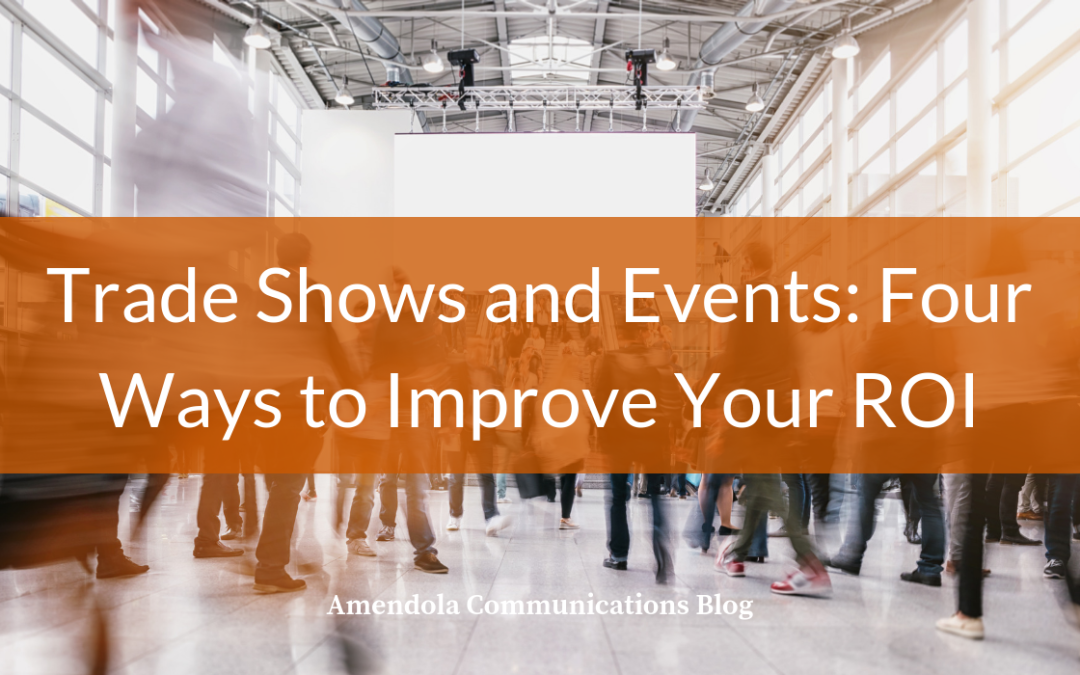
by Ken Krause | Jun 12, 2019 | Blog
Whether you personally believe trade shows are the land of opportunity or merely a relic of a bygone era where primitive being skulked through the aisles without the benefit of a smartphone, there is no question that they are still a fact of life for many of us. In fact, some (such as, oh, I dunno, HIMSS?) are not merely a minor blip on our radars but a huge disruptor to the otherwise semi-orderly flow of our lives.
Trade shows can be a time-sink as well as a budget-sink, so if you’re going to make that type of investment, it’s critically important that you be sure the organization gets something out of it. Something more than “exposure” and free leftover pens, tote bags and the kind of hard candy your grandmother gives you when you come to visit, and that you only eat when there is absolutely no other choice. Love you, grandma!
Toward that end (getting something out of your trade show investment, not getting hard candy), Amendola Communications CEO Jodi Amendola has written a blog post in her role as a member of the Forbes Agency Council. “Trade Show ROI: Four Ways to Make the Most Out of Industry Events” offers some great suggestions for ensuring marketers get a pat on the back rather than a kick in the backside for the results of their organization’s trade show efforts. The four tips include:
- Ensuring you have a well-honed elevator pitch that carefully walks the line between proper and over-the-top self-promotion
- Making Twitter your go-to social media platform for engaging other attendees
- Hosting a reception for clients and prospects
- Being sure you do something with all those leads you capture
Obviously there’s more to it than just those four bullet points, so it’s well worth giving the post a full read. You can do that here.
Whatever your personal feelings about trade shows, however, they still loom large in many industries – especially healthcare. So if you’re going to do it, do it right.
Take the time to prepare properly, and then maximize your time on the floor – whether you’re in front of the counter or behind it. It will pay off in the end.
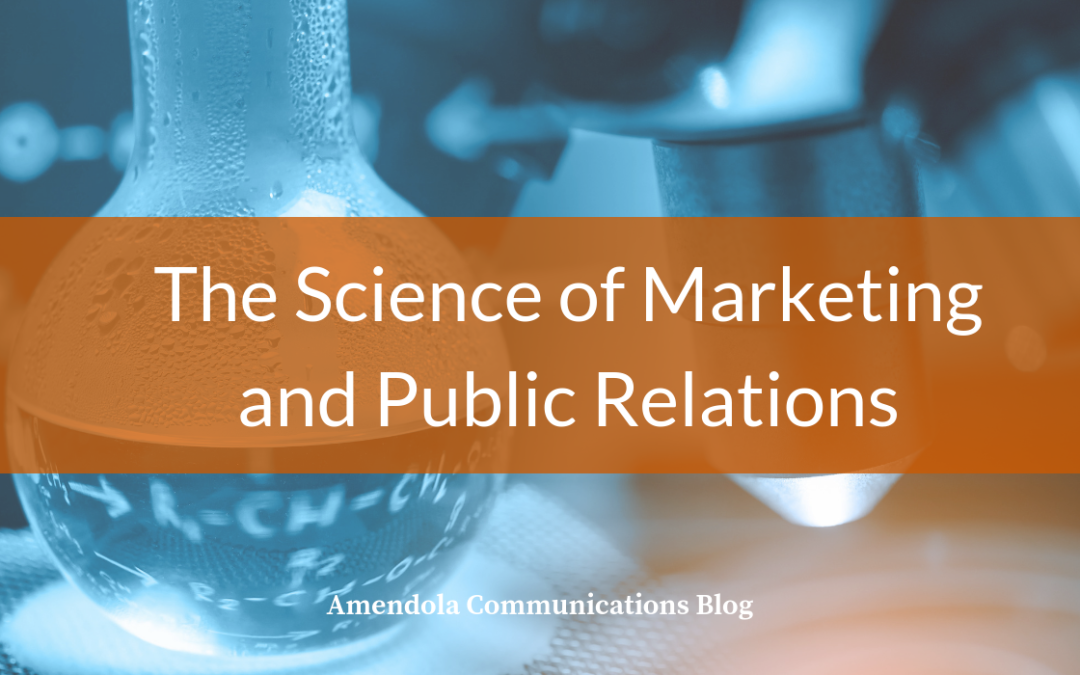
by Stacy State | Jun 5, 2019 | Blog
You got approval for a $3 million marketing budget from the C-suite.
While that may sound small to some and exorbitant to others the one guarantee is the marketing team will be required to “prove their value” after the money is spent.
Unlike some other departments who can say we bought 100 widgets at $1 instead of $2 saving the company $100 as marketing has grown more complex over the years, it has also become more difficult to show the return on investment at the end of the day.
But, we all know that saying “it’s difficult to measure” or even worse “we don’t know what value we got from that byline or advertisement” is not an acceptable response to leadership. The C-Suite, rightly so, wants to understand what they are getting for their money. Likewise, we wouldn’t pay thousands of dollars on a car without expecting it to work every day and last for several years. We want to know we got our money’s worth.
Marketers and public relations experts must learn the data and science of the profession. So, how do you measure a byline, a press release, an email campaign, social media, or an advertisement?
Step 1: Know the goals
Do not skip this step! Before embarking on an extensive marketing strategy that the team spent weeks putting together, know your company goals. What are leadership’s short-term and long-term plans? Is it a start-up needing more brand recognition or is it in a growth-stage needing quality lead generation?
Understanding where the company is today and where leadership is heading will help drive your marketing strategy. Share your marketing plans with the leadership team to get buy-in and agree upfront on the metrics that you plan to measure.
Step 2: Set the metrics and know the terminology
Now that you know the goals, it’s time to set your success metrics. How will you know if your plan is successful? Depending upon your strategy, you will use varying measures for different tactics. Below is a subset to consider.
Share of Voice (SOV): Measure the percentage of coverage and mentions of your brand in the media compared to your competitors.
Coverage: Track the number of times your brand is mentioned in the media along with where it is mentioned.
Website traffic: Google Analytics is a very useful tool to monitor unique page views, bounce rates, conversion rates, average session duration, and referral sites.
Domain authority: A term coined by Moz your domain authority ranking will compare your overall website, including SEO and keyword rankings, to give you a number 1-100. The higher the number the great authority your site holds within your industry.
Social Media: Track beginning and ending metrics including followers, likes and shares. Determine which content and messaging provides the greatest engagement with your audience.
Impressions and click-thru rates: With advertisements you will want to view not only the number of people that saw your ad but more importantly, how many clicked on your ad.
Conversion ratios: The percentage or ratio of people that clicked on an email, ad, or social content, etc. that then completed a call-to-action. This includes downloading content, completing a form for a demo, and even registering for a webinar.
Open rates and click-thru rates: When delivering emails or drip campaigns, you can monitor their success based upon the number of people that opened the email and the number of people that then clicked on a link within the email.
Cost-per-lead (CPL): To many in leadership, if you start speaking in terms of CPL you’ll be speaking their language. Calculating the costs of your activity divided by the number of leads you gained will give you the CPL.
Marketing qualified lead (MQL): While this one is probably one of the most important, the definition often varies from company to company. Typically, this is a lead that has a business need, understands what you offer, and has an interest in buying your product or service.
The metrics you choose should align appropriately with the tactics you will produce and the goals of your company. Putting these in place upfront will help avoid confusion at the end of the year.
Step 3: Make sure you have the right tools
While many marketers did not get into marketing to become data analysts, the move toward digital marketing requires a successful marketer to understand and use data wisely. Fortunately, many companies have developed tools to help analyze marketing results and prove value. There are many free or relatively inexpensive tools you can use to monitor your metrics.
Most marketers will start with free tools, and depending on the complexity of their business may purchase additional tools. Due to the overwhelming number of tools on the market, make sure you understand exactly what you are getting and any feature restrictions or limitations. In addition, make sure you use all the benefits of your marketing tools. Often you may purchase an email marketing tool without realizing you can also create landing pages, deliver social strategies and even host your webpages.
The key is not to get overwhelmed. Know what you need to measure and select the tools that are right for you.
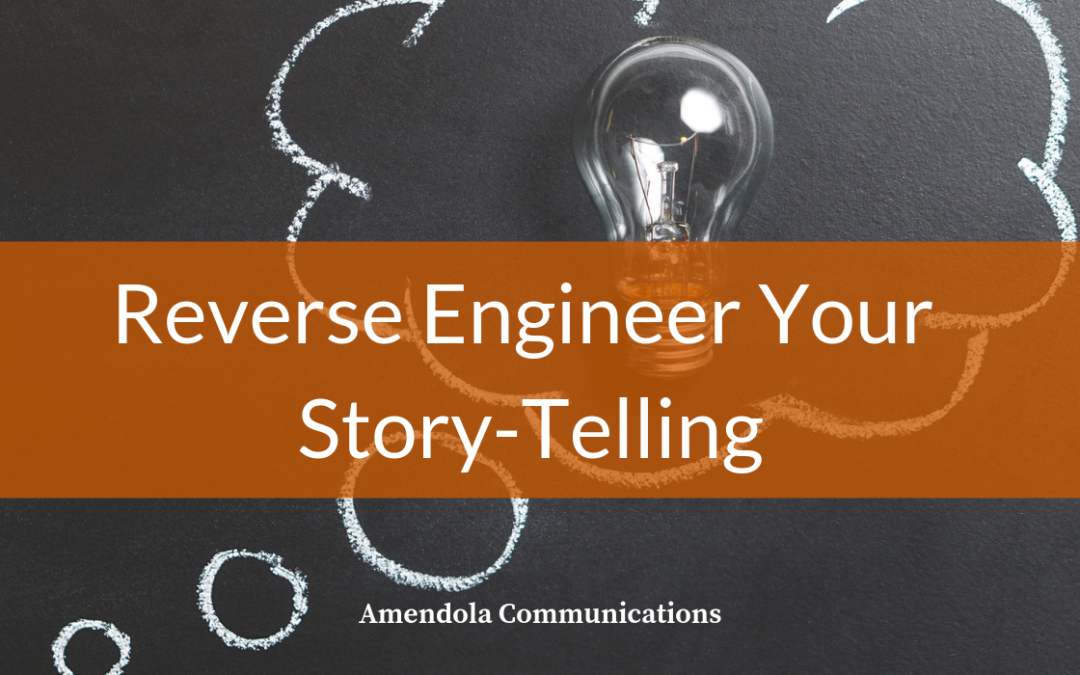
by Matt Schlossberg | May 22, 2019 | Blog
A couple of years ago, a client of mine who launched a health IT startup, marveled at the number of healthcare entrepreneurs who came up with a cool idea and then went in search of a market for it. In most cases, he told me, this approach found them struggling to find a toe-hold. The smart play was to study the market first, identify and understand the core challenges of the market’s customers, then develop a solution to overcome those challenges.
This very same problem afflicts many health IT companies when pitching the media. A company’s marketer or PR pro will identify a story about the company’s leadership, success with a client or the development of a new innovation then set out to find a reporter to write it up and publish it.
More often than not, the results leave much to be desired.
For sustained PR success, your content needs to fit the contours of whatever narrative or story journalists and editors are focusing on and that requires an ability to reverse-engineer those stories to match the priorities of the target journalist.
While you may believe that the story you want to tell is important, people outside of your organization probably don’t feel the same way at least, not without some modifications. It’s a hard lesson to internalize, I know. I have been fortunate to work with clients who I really believe in, but the inherent risk of that positive sentiment is an inability to look at a story from outside the four walls of the organization that wants to tell it.
While it’s tempting to jump right into the pool with a pitch, it’s often tactical and short-sighted. Even if you do generate a few quality media hits, they’ll be quickly pushed aside by the next piece of content and the one after that and the one after that.
When it comes to story-telling, I always start by asking my clients what results they want to achieve, then reverse-engineer a strategy to accomplish those goals. A friendly download will help set priorities and ensure that you are pursuing the right story-telling strategy.
For example, a company that wants to make a big splash at a massive conference like HIMSS should probably focus more on sponsored content buys for the main course, and use earned media as an extra side of gravy.
When earned media interviews and placements are the main prize, I like to start with a deeper, more granular narrative that aligns the client’s story with broader industry trends, research and compelling statistics and is collated into a pitch bible. This resource contains the main plot of the story the client wants to tell, but also includes a number of subplots and alternative narratives that allows me to cast my pitching net much wider.
It’s an extremely useful tool, because it allows you to quickly customize pitches based on a journalist’s priorities and beats. (You want to spend enough time on the front-end, so you can be quick and nimble on the back-end). It also allows you, as a marketer or PR pro, to see the forest for the trees; developing second and third wave pitching that will sustain over the course of weeks and months. This strategy also allows you to seamlessly align with other content developers, including marketers and social media managers for targeted outreach and creative amplification.
The writing of this broad narrative coincides with research into the target journalists and publications. What have they covered? Where are the logical places they will take their story-telling next? What specific hooks can I create that will convince them that my story is worth the time and effort to write?
Critically, how does all that research change they way I am telling my story and do those alterations still align with the client’s desired results?
In today’s environment, it’s no longer enough to have a story. Health IT is one of the most hyper-competitive industries around. Sustaining traction, much less enjoying inbound inquiries, in an ever-shrinking media environment is a constant challenge for all but the most well-known tech brands.
By identifying the challenges and desires of the media, you can reverse-engineer a story to meet those challenges and find enduring media success.





